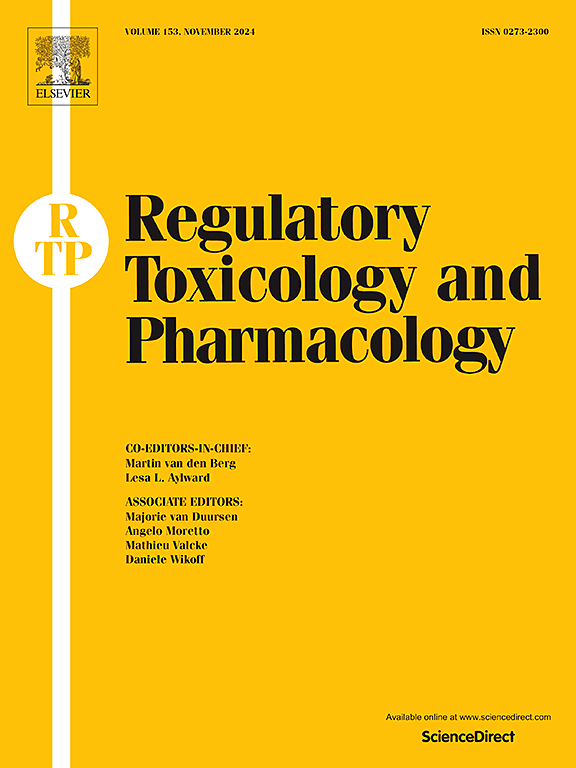N-Nitrosamine drug substance related impurities (NDSRIs) – A proposal for the addition of subcategories to carcinogenic potency categorization approach categories 1 and 2 for NDSRIs with a molecular weight > 200 Da
IF 3
4区 医学
Q1 MEDICINE, LEGAL
引用次数: 0
Abstract
The carcinogenicity potency categorization approach (CPCA) derived and harmonized by Health Authorities was a significant milestone, as it defined molecular properties that allowed for the rapid evaluation of the chemical structures of N-nitrosamine drug substance related impurities (NDSRIs) and the assignment of associated lifetime Acceptable Intake (AI) limits to inform on appropriate impurity control strategies in certain drug products. Nonetheless, it is important to continue to refine and improve on the CPCA based upon data-derived evidence. Herein, we focus on the default CPCA AI for NDSRIs, which is largely based on the small molecule N-nitrosamines (NAs). Considering the carcinogenic potency of NAs with a molecular weight >200 Da (NDSRIs molecular weight is typically 200–600 Da), we propose that in the absence of any compound specific data, the lowest lifetime Acceptable Intake for NAs, such as NDSRIs, should be 10x less (i.e., 150 ng/day) than the ICH M7 Threshold of Toxicological Concern of 1500 ng/day, (even for NDSRIs that are considered CPCA Category 1 and 2) which would conservatively result in a theoretical cancer risk of <1 in 100,000.
N-亚硝胺药物物质相关杂质(NDSRIs)--关于在致癌性分类方法类别 1 和 2 中增加分子量大于 200 Da 的 NDSRIs 子类别的建议。
由卫生当局制定和统一的致癌性效力分类方法(CPCA)是一个重要的里程碑,因为它定义了分子特性,从而可以快速评估与 N-亚硝胺药物物质相关的杂质(NDSRIs)的化学结构,并指定相关的终生可接受摄入量限值,为某些药物产品中适当的杂质控制策略提供信息。尽管如此,基于数据证据继续完善和改进 CPCA 仍然非常重要。在此,我们重点讨论 NDSRIs 的默认 CPCA AI,该 AI 主要基于小分子 N-亚硝胺(NAs)。考虑到分子量大于 200 Da 的 NAs 的致癌性(NDSRIs 的分子量通常为 200-600 Da),我们建议,在没有任何特定化合物数据的情况下,NDSRIs 等 NAs 的最低终生可摄入量应比 ICO 值低 10 倍(即 150 纳克/天)、150 纳克/天),低于 ICH M7 毒理学关注阈值(1500 纳克/天)(即使是被视为 CPCA 第 1 类和第 2 类的 NDSRIs)。
本文章由计算机程序翻译,如有差异,请以英文原文为准。
求助全文
约1分钟内获得全文
求助全文
来源期刊
CiteScore
6.70
自引率
8.80%
发文量
147
审稿时长
58 days
期刊介绍:
Regulatory Toxicology and Pharmacology publishes peer reviewed articles that involve the generation, evaluation, and interpretation of experimental animal and human data that are of direct importance and relevance for regulatory authorities with respect to toxicological and pharmacological regulations in society. All peer-reviewed articles that are published should be devoted to improve the protection of human health and environment. Reviews and discussions are welcomed that address legal and/or regulatory decisions with respect to risk assessment and management of toxicological and pharmacological compounds on a scientific basis. It addresses an international readership of scientists, risk assessors and managers, and other professionals active in the field of human and environmental health.
Types of peer-reviewed articles published:
-Original research articles of relevance for regulatory aspects covering aspects including, but not limited to:
1.Factors influencing human sensitivity
2.Exposure science related to risk assessment
3.Alternative toxicological test methods
4.Frameworks for evaluation and integration of data in regulatory evaluations
5.Harmonization across regulatory agencies
6.Read-across methods and evaluations
-Contemporary Reviews on policy related Research issues
-Letters to the Editor
-Guest Editorials (by Invitation)

 求助内容:
求助内容: 应助结果提醒方式:
应助结果提醒方式:


